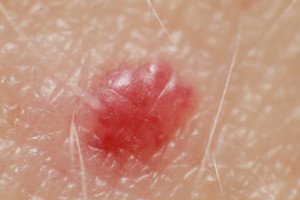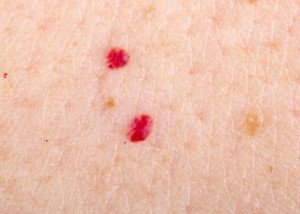
“Melanoma may look similar to an angioma, especially an amelanotic melanoma which are usually quickly growing pink or red bumps,” says Caroline A. Chang, MD, a board certified dermatologist and founder of the Rhode Island Dermatology Institute.
Many people get angiomas, which usually begin appearing after age 40.
They can appear just about anywhere, and some people have them all over their backs, torso and arms.
These red spots on the skin can be tinier than the tip of a pin or half the size of a pencil eraser and anywhere in between.
Are you scared that one of your angiomas might become a melanoma?
For some individuals, this fear may be driven by the very term “angioma,” because “oma” is the suffix for cancer types.
However, “oma” does not mean cancer; it means mass. And a mass can be benign — as well as malignant.
“Angiomas are collections of blood vessels that grow under the skin,” says Dr. Chang.
“There are no melanoma or mole cells usually associated with an angioma.
“Therefore, in the plainest of terms, angiomas cannot ‘turn into’ melanoma.
“So if you develop a quickly growing bump, no matter what shape or color, make sure to have it checked out by a dermatologist.”
Though a melanoma may, by chance, begin developing very close to or within these concentrations of blood vessels, this still does not mean a cause and effect relationship; rather, think of it as a coincidence of real estate.

Dr. Chang practices general and cosmetic dermatology, and has particular expertise in melanoma and the use of dermoscopy for mole monitoring.
 Lorra Garrick has been covering medical, fitness and cybersecurity topics for many years, having written thousands of articles for print magazines and websites, including as a ghostwriter. She’s also a former ACE-certified personal trainer.
Lorra Garrick has been covering medical, fitness and cybersecurity topics for many years, having written thousands of articles for print magazines and websites, including as a ghostwriter. She’s also a former ACE-certified personal trainer.
.









































